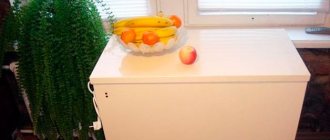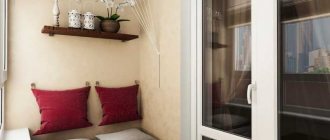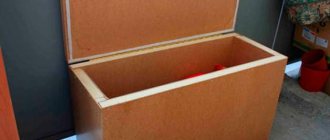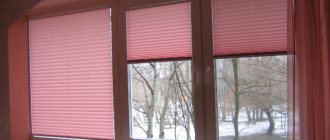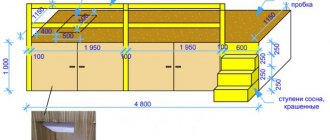Unlike owners of country houses (with a garage and basement), for residents of city apartments, organizing the storage of vegetables can become a real problem.
Too high or, conversely, low air temperature on the balcony, bright sunlight significantly reduces the shelf life of vegetable stocks.
Special boxes for storing vegetables on the balcony will help solve the problem. Diverse in design and materials of manufacture, they will forever solve the problem of how to store on the balcony a crop grown with your own hands or a supply of vegetables purchased at the market.
What are they?
A box for storing vegetables (balcony cellar, thermal storage), as they call a container, thanks to which you can preserve the harvest of root vegetables on the balcony of a city apartment. Depending on the materials of manufacture and operational characteristics, all boxes for storing vegetables are divided into two groups.
Flexible Balcony Storage
Externally, a flexible cellar is a bag sewn from several layers of thick textile impregnated with a special water-repellent compound and soft padding polyester.
The absence of clear forms solves the problem of limited balcony space. The bag fits easily under a table or bench, and when there is no need to use the cellar, it can easily be rolled up and stored in a closet.
Flexible balcony storages are equipped with a special thermostat , which allows you to maintain the required temperature for storing vegetables inside the box at any time of the year. The cost of textile boxes varies from 6,500 rubles. up to 10,000 rub.
Hard cellar (thermal cabinet)
These are steel, rather bulky boxes for storing vegetables. The outside of the cellar is covered with powder paint, protecting the metal from corrosion. The inside of the heating cabinet is lined with extruded polystyrene foam.
To maintain the necessary microclimate, ensuring high-quality storage of vegetables, the oven is equipped with a thermostat and a forced ventilation system. This feature allows the cellar to be used year-round (at temperatures from -35°C to +35°C).
The average cost of a heating cabinet is 20,000 rubles. Since a stationary thermal box for storing vegetables operates from the mains electricity , before purchasing it is important to check whether there is an outlet installed on the balcony (if not, you will have to spend money on its installation).
How to do it yourself?
It’s not difficult to assemble a box for storing vegetables with your own hands. Just a little patience and available materials and the much-needed storage for vegetables on the farm is ready.
Let's look at an example of how to assemble a box for storing vegetables on an insulated balcony with your own hands:
- Determine the dimensions of the box. To do this, you need to measure the free space on the balcony, which can later be used for the container.
- We cut a wooden beam for the future frame.
We begin assembling the frame.
First of all, we assemble the base. Four vertical posts are fixed to it. All elements are connected to each other with self-tapping screws (for strength, you can additionally use metal corners).- We assemble the base of the lid from the beams.
- We lay a layer of foam plastic on the bottom of the box, after which we cover the body with a board. An important point: in order to maintain the required level of humidity in the box, the boards must be filled with a gap of 1-2 cm.
- The lid is sheathed with a board and attached on hinges to the body of the box.
After the vegetable storage chest is assembled, it must be coated with water-based varnish. This will not only protect the wood from rotting, but will also give it a pleasant shine.
If the balcony is cold and the air temperature in winter drops below +5°C, the box must be insulated. For this:
- The inside of the container is lined with foam plastic (the thicker the layer, the better). The bottom and lid must be insulated.
- An internal storage container is inserted into the insulated box. To do this, measurements are made of the free internal space of the box, according to which another box is assembled from wooden beams and chipboard sheets. An important point: holes for ventilation must be drilled in the walls of the inner container.
- Place the box for storing vegetables in an insulated box. The box is ready!
If desired, according to the size of the box lid, you can sew a soft seat (foam rubber covered with fabric). The seat will not only serve as additional insulation for the vegetable storage, but will also turn the box into an additional place to relax.
The video will show you how to make a box for storing vegetables on the balcony:
Cellar under the balcony
Owners of apartments located on the first floors of multi-storey buildings have an advantage over the higher floors. They can make a cellar under the balcony. As a rule, permission to carry out such changes is given by the relevant organizations (housing office) without obstacles, except in cases where the balcony faces the main street, and its transformation will affect the appearance of the facade.
How to make a cellar under the balcony:
- A hole is cut in the balcony slab to allow an adult to pass freely. First, the contours of the hole are cut out with a grinder, and then a layer of concrete is knocked out. The reinforcement bars are also cut with a grinder;
- A pit is dug under the balcony, the width and length of which corresponds to the dimensions of the balcony slab. Its depth should be such that you can stand in the hole without resting your head on the slab. The higher the ground part of the base of the house, the shallower the depth the hole is dug;
- The floor and walls are covered with inexpensive waterproofing, preferably roofing felt. The strips are overlapped and soldered using a gas torch;
- The bottom is covered with a layer of sand and crushed stone, reinforced with steel mesh or rod, and filled with cement screed;
- The walls are laid half a brick thick, from the floor to the balcony slab. A ventilation pipe is installed at the ground level, or a hole is left in the wall, which is subsequently closed with a grate;
- The walls are lined from the inside with one of the insulating materials: mineral wool, polyurethane foam and others. On an unheated balcony, you also need to insulate the floor slab. The type of insulation and layer thickness depend on the climatic conditions of the area;
- A staircase with wide steps and a hatch are installed. It is better to make the lid and stairs wooden, since wood has low thermal conductivity. The inside of the hatch is also insulated.
How to choose?
Among the wide range of boxes for storing vegetables, it is quite difficult to choose the most suitable option for yourself.
To avoid mistakes, you need to determine several points before purchasing:
- the dimensions of the box (an important decision-making factor is the availability of free space on the balcony);
- material of manufacture (the quality and safety of wood, metal or plastic must be confirmed by appropriate certificates);
- the presence of ventilation and thermal insulation (necessary conditions for high-quality storage of vegetables).
Flexible cellars and wooden boxes without heating are a good option for insulated balconies. If the air temperature on the balcony in winter drops below +5°C, you cannot do without a heated thermobox.
Floor installation
The choice of material for flooring is largely determined by what loads it will have to withstand during further operation. It can be produced:
wood - beams or logs on which boards or beams are laid on top. Since there is always high humidity in the cellar, all wooden elements must be treated with an antiseptic
When building a cellar, all wooden elements must be treated with an antiseptic
Country cellar decorated with climbing plants
- metal beams on which concrete slabs can be laid. In this case, it is necessary to especially carefully process and seal the seams (joints of plates)
- monolithic concrete floor - poured in the same way as monolithic walls
Anyone can build a cellar with their own hands at the dacha
TOP 3 best models
You can buy a box for storing vegetables on the balcony in the online store. It is enough to type “cellar” or “thermal box” in the search bar and the system will display a fairly extensive list of sites and stores selling similar goods. Among the variety of thermal storage facilities, the following models deserve special attention:
Balcony heating cabinet EDS Cellar 95 l
A flexible container made of three-layer textile material impregnated with a special water-repellent composition. The outer layer is padding polyester. A flexible wire heater maintains the required temperature for storing vegetables inside a soft container.
In order to set the necessary parameters, you need to press the button on the panel. After this, the bag is loaded with vegetables, carefully sorted into mesh bags (included). If necessary, the flexible balcony storage unit can be fixed to the wall (the kit includes two dowels and screws).
The average cost of a thermal cellar is 6,500 rubles.
Year-round cellar Predictor 180 l
Regardless of external conditions, it maintains the optimal storage temperature inside the box from +2°C to +10°C. Can operate in both heating and cooling modes .
The metal body is covered with a wear-resistant polymer that protects the cellar from mechanical damage. A spacious (180 l) container helps preserve healthy and tasty vegetables throughout the winter. The average cost is 40,500 rubles.
Thermal cabinet "Winter cellar"
Maximum volume (360 l) heated chest . The digital panel simplifies the process of setting the desired temperature inside the box as much as possible. Just press the button and look at the specified parameter on the display.
The heating cabinet can be operated at extremely low temperatures (down to -35°C). To operate the heating element, one 220V socket is enough (electricity consumption is only 225 W).
Using the oven is very simple : just load the nets with vegetables into the cabinet, close the door tightly, and use the buttons on the control panel to set the desired temperature. The average cost is 25,000 rubles.
When is additional heating needed?
When installing a vegetable box on a cold (uninsulated) balcony, where the air temperature in winter drops below -5 °C, it would be a good idea to take care of additional heating of the container. As an option, you can use film heated floors.
Algorithm of actions:
- Cut out a piece of film flooring in places specially marked by the manufacturer, identical in size to the bottom of the storage box.
- Place a film covering on the bottom of the box, connect it to the thermostat built into the outside of the box.
- Connect the heated floor to the network.
Installing a heated floor will not raise any questions if you carefully read the film coating manufacturer’s instructions before starting work.
What is a household heating cabinet
The invention of a household thermal cabinet is a wall-mounted or floor-mounted thermal container for organizing the storage of agricultural products. This type of garden furniture was officially introduced into production and patented in 2001 by Nikolai Ivanovich Berezhny and Andrey Semenovich Novikov. The very idea of such an invention, thanks to which it would be possible to store various vegetables, fruits and preserves at home and without loss of food, appeared in 1998.
At that time, Russia was still going through quite difficult post-perestroika years. The population really needed such an additional closet in the form of a cellar, since people had to survive only thanks to agricultural products, and personal production. This was especially true in remote areas of the country. An additional convenience of this invention is that it saves space as much as possible, since its elongated hinged design involves unloading the floor.
Nowadays, the economic situation has stabilized somewhat, but with the growing interest in gardening, the heating cabinet has not lost its relevance and is an excellent solution for many owners of private farmland.
What vegetables can be stored?
Provided the required air temperature is maintained, vegetables such as:
- beet,
- cabbage,
- onion,
- garlic,
- carrot,
- potato.
| The product's name | Storage temperature |
| potato | from +2 to +3 0С |
| carrots, beets, turnips | from 0 to +2 0С |
| garlic | from -1 to +3 0С |
| onion | from 0 to +1 0С |
| cabbage | from -1 to +2 0С |
Vegetables are stored in a well-shaded, ventilated, cool place (special boxes fully meet all the requirements for proper storage).
Cucumbers, tomatoes, zucchini are vegetables that cannot be stored on the balcony for a long time. For the winter, cucumbers and tomatoes are fermented or pickled. Zucchini retains its nutritional properties perfectly when frozen.
In the underground loggia
For such a cellar it is not necessary to have a balcony with a lot of free space. It can be built on the smallest loggia. Three-liter jars, of course, are unlikely to fit under the floor of your balcony, but jars with a capacity of half a liter to one and a half liter are fine! This type of cellar is the most common, so in our article we will look at instructions for building it yourself.
The first thing you need to do is take measurements. Arm yourself with a centimeter and determine how many centimeters it is possible to raise the floor on the balcony. Next, you need to insulate the concrete floor of the balcony. In order to save space, it is better to use foil polyethylene foam. The floor should be rigid and not sag, so it would be best to make it from boards up to 2 centimeters thick. All that remains is to cut out the hatch and attach the door. It can be made either folding or sliding.
Adviсe
Only dry, sorted vegetables, without signs of rot, are placed in boxes. Supplies are checked periodically to remove spoiled products .
Otherwise, regardless of the storage temperature, the entire crop of root crops will be spoiled.
An old, non-working refrigerator is a good alternative to store-bought vegetable storage boxes. Before use, the refrigerator is well ventilated and then placed on the floor with the door facing up.
The sorted vegetables are placed in the refrigerator (the shelves are used as partitions), covered with a clean cloth, and then the door of the improvised storage is closed.

